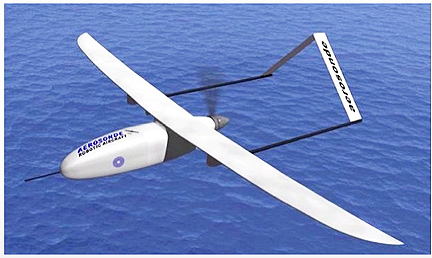Satnews Daily
October 21st, 2009
7K Icy Miles For AAI's Aerosonde UAV
AAI Corporation's Aerosonde small unmanned aircraft and air crew participated in a six-week University of Colorado exploration of the cold, rough katabatic winds present on the coast of Antarctica. After extensive observation, University of Colorado scientists can now generate highly detailed, three-dimensional maps to help study the katabatic winds' relationship to Antarctic sea ice formation. AAI's crew flew four Aerosonde aircraft, which logged more than 130 flight hours and flew nearly 7,000 miles during their 16 flights.
 For this mission, the Aerosonde aircraft were fitted with meteorological instruments to measure pressure, temperature, relative humidity, winds, net radiation, surface temperature and ice thickness. AAI also integrated satellite communications equipment onto the aircraft to enable beyond-line-of-sight aircraft control. The durable Aerosonde Mark 4 aircraft flew in temperatures as cold as -38 degrees Celsius, and remained aloft up to 17 straight hours during its mission to Terra Nova Bay, the focus of the project. This site was chosen because of the particularly strong katabatic winds present there, as well as its wide expanse of open water surrounded by sea ice. The Aerosonde aircraft has taken part in other, similarly perilous meteorological research missions. As part of its previous work with NASA and the National Oceanic and Atmospheric Administration, an Aerosonde aircraft completed a history-making flight into Hurricane Noel in November 2007. It was the first hurricane mission in which an unmanned aircraft was able to explore the storm's eye and the eye wall. The 17-hour, 27-minute flight duration was a record for unmanned aircraft hurricane missions, and the Aerosonde aircraft gathered data from as low as 300 feet above the ocean's surface. In 2001, Aerosonde aircraft were utilized to gather atmospheric and environmental data in Barrow, Alaska, in support of University of Colorado/National Science Foundation research on Arctic warming and regional climate change. The aircraft accumulated more than 1,000 flight hours over five years during this research mission.
For this mission, the Aerosonde aircraft were fitted with meteorological instruments to measure pressure, temperature, relative humidity, winds, net radiation, surface temperature and ice thickness. AAI also integrated satellite communications equipment onto the aircraft to enable beyond-line-of-sight aircraft control. The durable Aerosonde Mark 4 aircraft flew in temperatures as cold as -38 degrees Celsius, and remained aloft up to 17 straight hours during its mission to Terra Nova Bay, the focus of the project. This site was chosen because of the particularly strong katabatic winds present there, as well as its wide expanse of open water surrounded by sea ice. The Aerosonde aircraft has taken part in other, similarly perilous meteorological research missions. As part of its previous work with NASA and the National Oceanic and Atmospheric Administration, an Aerosonde aircraft completed a history-making flight into Hurricane Noel in November 2007. It was the first hurricane mission in which an unmanned aircraft was able to explore the storm's eye and the eye wall. The 17-hour, 27-minute flight duration was a record for unmanned aircraft hurricane missions, and the Aerosonde aircraft gathered data from as low as 300 feet above the ocean's surface. In 2001, Aerosonde aircraft were utilized to gather atmospheric and environmental data in Barrow, Alaska, in support of University of Colorado/National Science Foundation research on Arctic warming and regional climate change. The aircraft accumulated more than 1,000 flight hours over five years during this research mission.

